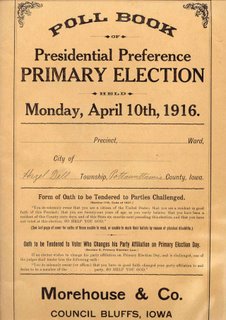Primary Colors
 The Speaker's proposal, made during his inaugural address, to move Illinois' presidential primary from March 18 to February 5 certainly caught a lot of people, including the Obama campaign, off-guard.
The Speaker's proposal, made during his inaugural address, to move Illinois' presidential primary from March 18 to February 5 certainly caught a lot of people, including the Obama campaign, off-guard.And there is enough speculation as to the motivations of 'He Who Does Nothing Without a Plan', that I am not going to add my own theories to the mix at this point (although I do have some good ones).
I wholeheartedly agree that the present system puts waaay too much emphasis on states that are non-reflective of the country as a whole, while at the same time relegating other significant states to irrelevance when it comes to selecting presidential nominees.
But at the same time, I also am wary of the costs and logistics of having a presidential primary at a different time from the primaries for the rest of the elected offices. It is hard enough to get people to vote as is, and I think that a bifurcated primary would only serve to further depress turnout for 'down ticket' races.
Instead, I'll invite you to think about a plan offered several years ago by the National Association of Secretaries of State which involves rotating regional presidential primaries. The proposal divides the country into four geographic areas (Eastern, Southern, Midwestern and Western) and rotates which region would vote first each March. The other regions would hold their primary elections in April, May, and June. A different part of the country would vote first once in each sixteen year cycle.
Under the plan, traditional early primary/caucus states New Hampshire and Iowa retain early election status so that under-funded and less widely known candidates will still have an opportunity to compete through retail one-on-one politics rather than the costly media-driven campaigns that are required in larger states.
The NASS plan would create four primary regions:
Southern Region
Alabama, Arkansas, Florida, Georgia, Kentucky, Louisiana, Mississippi, North Carolina, Oklahoma, South Carolina, Tennessee, Texas, Virginia, Puerto Rico and the Virgin Islands.
Eastern Region
Connecticut, Delaware, Maine, Maryland, Massachusetts, New Jersey, New York, Pennsylvania, Rhode Island, Vermont, West Virginia and the District of Columbia.
Midwestern Region
Illinois, Indiana, Kansas, Michigan, Minnesota, Missouri, Nebraska, North Dakota, Ohio, South Dakota and Wisconsin.
Western Region
Alaska, Arizona, California, Colorado, Hawaii, Idaho, Montana, Nevada, New Mexico, Oregon, Utah, Washington, Wyoming and Guam.
Now under this plan, once every 16 years, we would have a primary as late as June, which many good government advocates would like, but does not sit well with many party regulars. Personally, I think that a campaign is a campaign, whether your primary is in February or June. And having less time between a primary election and a general election may in fact provide for a more concentrated campaign.
While I am not sure that the NASS plan is the best idea out there, I do think that is is preferable to our present system.

5 Comments:
A good idea in theory, but you need to base the regions on population and make them equal in sizes. And make sure that every 10 years they still remain equal based on the number of electoral votes.
Let's try a simple change that can be achieved in time for '08: Move the whole primary to Feb. 5, including the legislative primary.
Taxpayers shouldn't be forced to pay for primary elections, and primaries shouldn't even be regulated by the state. Political parties are private, voluntary associations; and the internal candidate selection that they use is their own business. Anyone unhappy with a party's candidate selection process is free to (1) try to change it, (2) join another political party, and (3) start a new political party.
I think a change needs to be made in the primary system primarily the fact that the candidate is already determined before all the primaries are finished. As in say 2004 John Kerry was the Democratic nominee before he even was up for the primary election in Illinois.
Also I have never understood why why New Hampshire and Iowa have to insist on being first. What is the rationale for that?
I did not realize he only wanted to move ther Presidential primary and not rest of primary. What a genius, he will control the state primary with all five of the people who come out to vote for the general primary in March.
Post a Comment
<< Home